Study of the Self-Healing Performance of Semi-Flexible Pavement Materials Grouted with Engineered Cementitious Composites Mortar based on a Non-Standard Test
Abstract
:1. Introduction
2. Experimental Design
2.1. Materials
2.1.1. Asphalt and Aggregates
2.1.2. Powder Mortar
2.1.3. Engineered Cementitious Composites
2.2. Matrix Asphalt Mixture
2.3. Engineered Cementitious Composites(ECC) Mortar
2.3.1. Test of Fluidity
2.3.2. Strength Test for Mortar
2.3.3. Self-Healing Test of Mortar
2.4. The Semi-Flexible Pavement (SFP) Materials
2.4.1. Specimen Grouting
2.4.2. Marshall Stability Test
2.4.3. Three-Point Bending Test
2.4.4. Self-Healing Test of the Semi-Flexible Pavement (SFP) Materials
3. Results and Discussion
3.1. Mortar
3.1.1. Fluidity
3.1.2. Flexural Strength and Compressive Strength of Mortar
3.1.3. Self-Healing Evaluation of Mortar
3.2. Semi-Flexible Pavement (SFP) Materials
3.2.1. Marshall Test
3.2.2. Three-Point Bending Test
3.2.3. Self-Healing Evaluation of ECC-SFP Materials
4. Conclusions
Author Contributions
Funding
Conflicts of Interest
References
- Yang, Y.; Huang, S.L.; Ding, Q.J. The property research on interfacial medicated semi-flexible pavement material. Appl. Mech. Mater. 2011, 71–78, 1090–1098. [Google Scholar]
- Ding, Q.J.; Sun, Z.; Shen, F.; Huang, S.L. The performance analysis of semi-flexible pavement by the volume parameter of matrix asphalt mixture. Adv. Mater. Res. 2011, 168, 351–356. [Google Scholar] [CrossRef]
- Ding, Q.J.; Zhao, M.Y.; Shen, F. Mechanical behavior and failure mechanism of recycled semi-flexible pavement material. J. Wuhan Univ. Technol. Mater. Sci. Ed. 2015, 30, 981–988. [Google Scholar] [CrossRef]
- Setyawan, A. Assessing the Compressive Strength Properties of Semi-Flexible Pavements. Proced. Eng. 2013, 54, 863–874. [Google Scholar] [CrossRef]
- Ling, T.Q.; Zhao, Z.J.; Xiong, C.H. The application of semi-flexible pavement on heavy traffic roads. Int. J. Pavement Res. Technol. 2009, 2, 211–217. [Google Scholar]
- Husain, N.M.; Karim, M.R.; Mahmud, H.B.; Koting, S. Effects of aggregate gradation on the physical properties of semiflexible pavement. Adv. Mater. Sci. Eng. 2014. [Google Scholar] [CrossRef]
- Vila-Cortavitarte, M.; Jato-Espino, D.; Castro-Fresno, D.; Calzada-Pérez, M.Á. Self-healing capacity of asphalt mixtures including by-products both as aggregates and heating inductors. Materials 2018, 11, 800. [Google Scholar] [CrossRef]
- Tran, T.N.; Nguyen, H.T.T.; Nguyen, K.S.; Nguyen, H.N.T. Semi-flexible Material: The Sustainable Alternative for the Use of Conventional Road Materials in Heavy-Duty Pavement. In Proceedings of the 4th Congrès International de Géotechnique-Ouvrages-Structures, Singapore, 26–27 October 2017. [Google Scholar]
- Pei, J.Z.; Cai, J.; Zou, D. Design and performance validation of high-performance cement paste as a grouting material for semi-flexible pavement. Constr. Build. Mater. 2016, 126, 206–217. [Google Scholar] [CrossRef]
- Wang, Y.J.; Guo, C.Y.; Tian, Y.F.; Wang, J.J. Design of mix proportion of cement mortar with high-performance composite semi-flexible pavement. Adv. Mater. Res. 2013, 641–642, 342–345. [Google Scholar] [CrossRef]
- Suhana, K.; Mohamed, R.K.; Hilmibin, M.; Norjidah, A.A.H. Mechanical properties of cement-bitumen composites for semi-flexible pavement surfacing. Baltic J. Road Bridge Eng. 2014, 9, 191–199. [Google Scholar]
- Yang, B.; Weng, X. The influence on the durability of semi-flexible airport pavement materials to cyclic wheel load test. Constr. Build. Mater. 2015, 98, 171–175. [Google Scholar] [CrossRef]
- Zhang, J.; Cai, J.; Pei, J.Z. Formulation and performance comparison of grouting materials for semi-flexible pavement. Constr. Build. Mater. 2016, 115, 582–592. [Google Scholar] [CrossRef]
- Hong, J.X.; Wang, K.J.; Xiong, Z.J.; Gong, M.H.; Deng, C.; Peng, G.; Zhu, H.R. Investigation into the freeze–thaw durability of semi-flexible pavement mixtures. Road Mater. Pavement Design 2019, 20, 1–17. [Google Scholar] [CrossRef]
- Sun, D.Q.; Sun, G.Q.; Zhu, X.Y.; Guarin, A.; Li, B.; Dai, Z.W.; Ling, J.M. A comprehensive review of self-healing of asphalt materials: Mechanism, model, characterization and enhancement. Adv. Colloid Interface Sci. 2018, 256, 65–93. [Google Scholar] [CrossRef]
- Little, D.N.; Lytton, R.L.; Chairl, B.; Williams, D.; Texas, A. An analysis of the mechanism of micro damage healing based on the application of micromechanics first principles of fracture and healing. J. Assoc. Asphalt Paving Technol. 1999, 68, 501–542. [Google Scholar]
- Mohammad, A.G.; Esmail, A. Application of nano-silica and styrene-butadiene-styrene to improve asphalt mixture self healing. Int. J. Pavement Eng. 2019, 20, 89–99. [Google Scholar]
- Giorgia, M.; Amedeo, V.; Francesco, C. Influence of different fillers and SBS modified bituminous blends on fatigue, self-healing and thixotropic performance of mastics. Road Mater. Pavement Design 2019, 20, 656–670. [Google Scholar]
- Xu, S.; Liu, X.Y.; Amir, T.; Erik, S. Investigation of the potential use of calcium alginate capsules for self-healing in porous asphalt concrete. Materials 2019, 12, 168. [Google Scholar] [CrossRef]
- Wang, C.; Xie, W.; Underwood, B.S. Fatigue and healing performance assessment of asphalt binder from rheological and chemical characteristics. Mater. Struct. 2018, 51. [Google Scholar] [CrossRef]
- Fan, S.P.; Wang, H.; Zhu, H.Z.; Sun, W. Evaluation of self-healing performance of asphalt concrete for low-temperature fracture using semicircular bending test. J. Mater. Civil Eng. 2018, 30, 04018218. [Google Scholar] [CrossRef]
- Sun, D.Q.; Li, B.; Ye, F.Y.; Zhu, X.Y.; Lu, T.; Tian, Y. Fatigue behavior of microcapsule-induced self-healing asphalt concrete. J. Clean. Prod. 2018, 188, 466–476. [Google Scholar] [CrossRef]
- Wu, G.X.; Wang, Y.; Wan, R.Y. A study of the strength mechanism of semi-flexible composite pavement material and a modified method for the determination of its compressive resilient modulus. In Proceedings of the 10th International Conference of Chinese Transportation Professionals (ICCTP), Beijing, China, 4–8 August 2010. [Google Scholar]
- Specifications for Special Mortar Semi-Flexible Pavement Application Technology; DB44/T 1296; Administration of Quality and Technology Supervision of Guangdong Province: Guangzhou, China, 2014.
- Wang, W.M.; Gao, D.; Wu, K.H. The research of performance on semi-flexible pavement materials. Highw. Eng. 2014, 39, 78–82. [Google Scholar]
- Wang, F.H.; Wang, W.M.; Wu, K.H. Study on the design and performance of large void basic asphalt mixture for semi-flexible pavement. Highw. Eng. 2015, 40, 72–76. [Google Scholar]
- Wu, M.; Johannesson, B.; Geiker, M. A review self-healing in cementitious material and engineered cementitious composites as a self-healing material. Constr. Build. Mater. 2012, 28, 571–583. [Google Scholar] [CrossRef]
- Ali, M.A.E.M.; Nehdi, M.L. Innovation crack-healing hybrid fiber reinforced engineered cementitious composites. Constr. Build. Mater. 2017, 150, 689–702. [Google Scholar] [CrossRef]
- Liu, H.Z.; Zhang, Q.; Gu, C.S. Self-healing of microcracks in Engineered cementitious composites under sulfate and chloride environment. Constr. Build. Mater. 2017, 153, 948–956. [Google Scholar] [CrossRef]
- Wu, C.; Pan, Y.; Ueda, T. Characterization of the abrasion resistance and the acoustic wave attenuation of the engineered cementitious composites for runway pavement. Constr. Build. Mater. 2018, 174, 537–546. [Google Scholar] [CrossRef]
- Zeng, M.L.; Nan, D.; Wu, C.F.; Zhu, T. Research on self-healing performance of PVA-ECC stabilized crushed-stone mixture. J. Highw. Transp. Res. Dev. 2015, 32, 42–45. [Google Scholar]
- Jiang, J.W.; Ni, F.J.; Wu, F.; Husam, S.; Lv, Q. Evaluation of the healing potential of asphalt mixtures based on a modified semi-circular bending test. Constr. Build. Mater. 2019, 196, 284–294. [Google Scholar] [CrossRef]
- Test Methods of Cement and Concrete for Highway Engineering; JTG E30; China Communications Press: Beijing, China, 2005.
- Standard Test Methods of Bitumen and Mixtures for Highway Engineering; JTG E20; China Communications Press: Beijing, China, 2011.
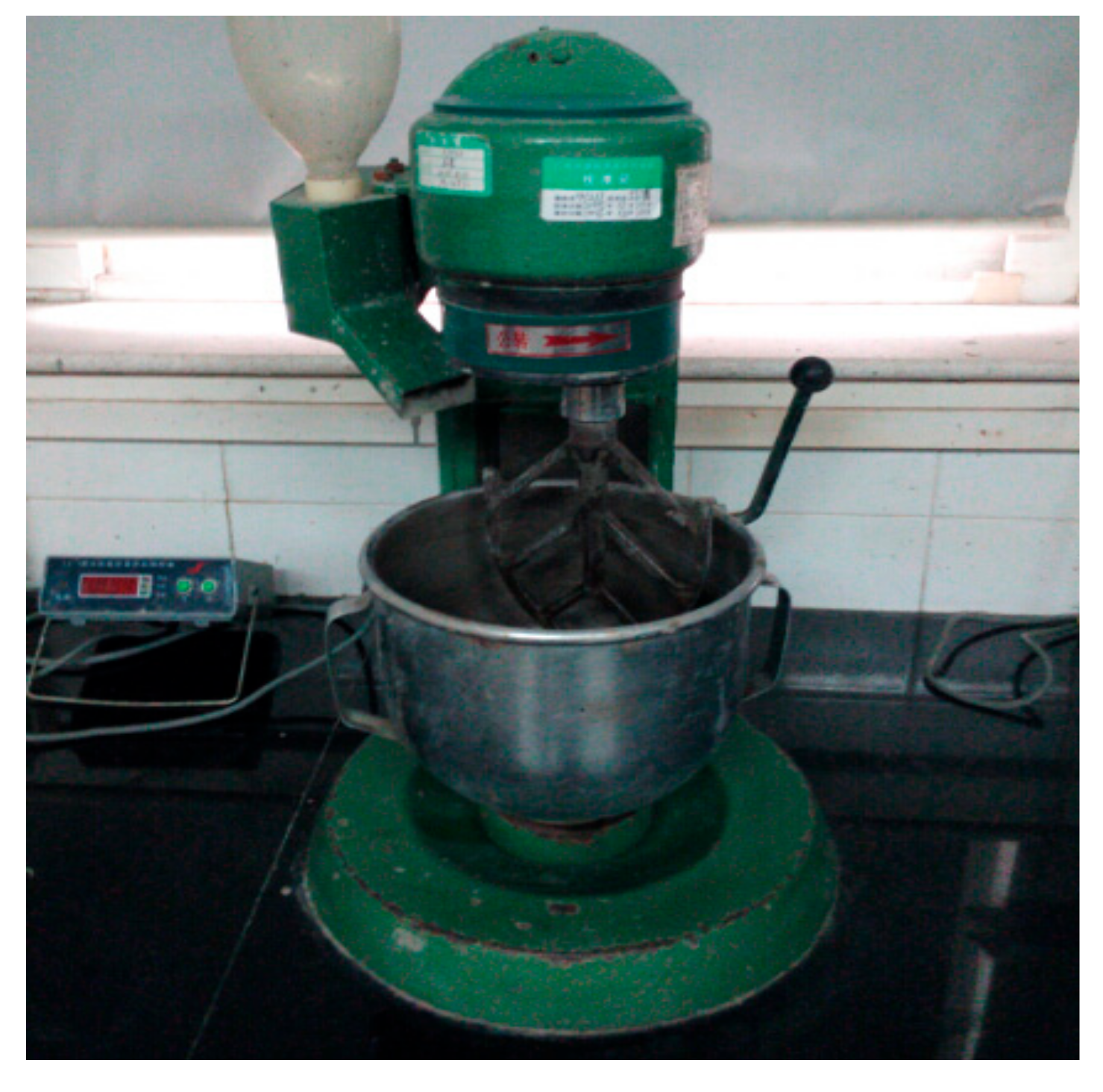
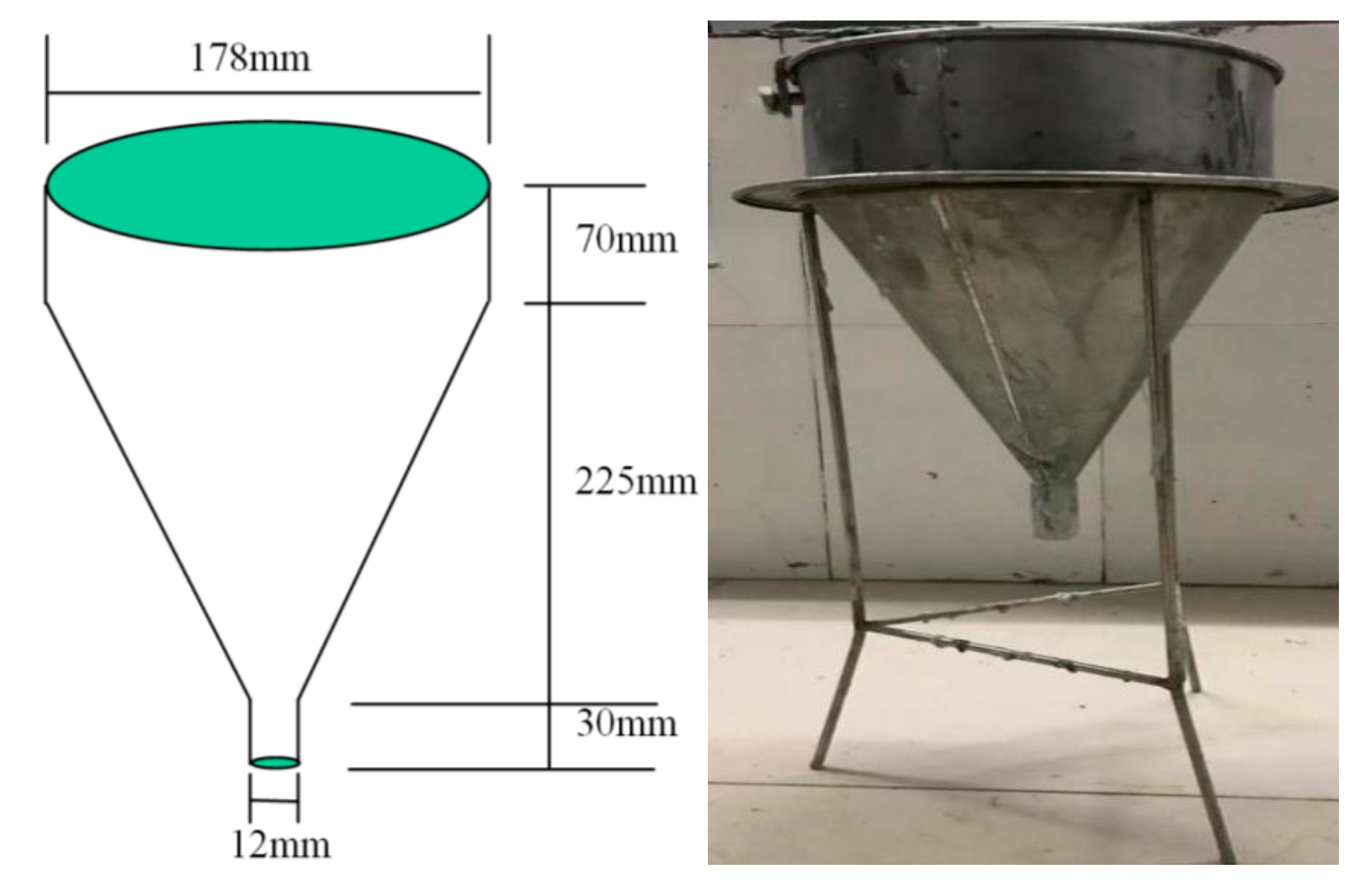

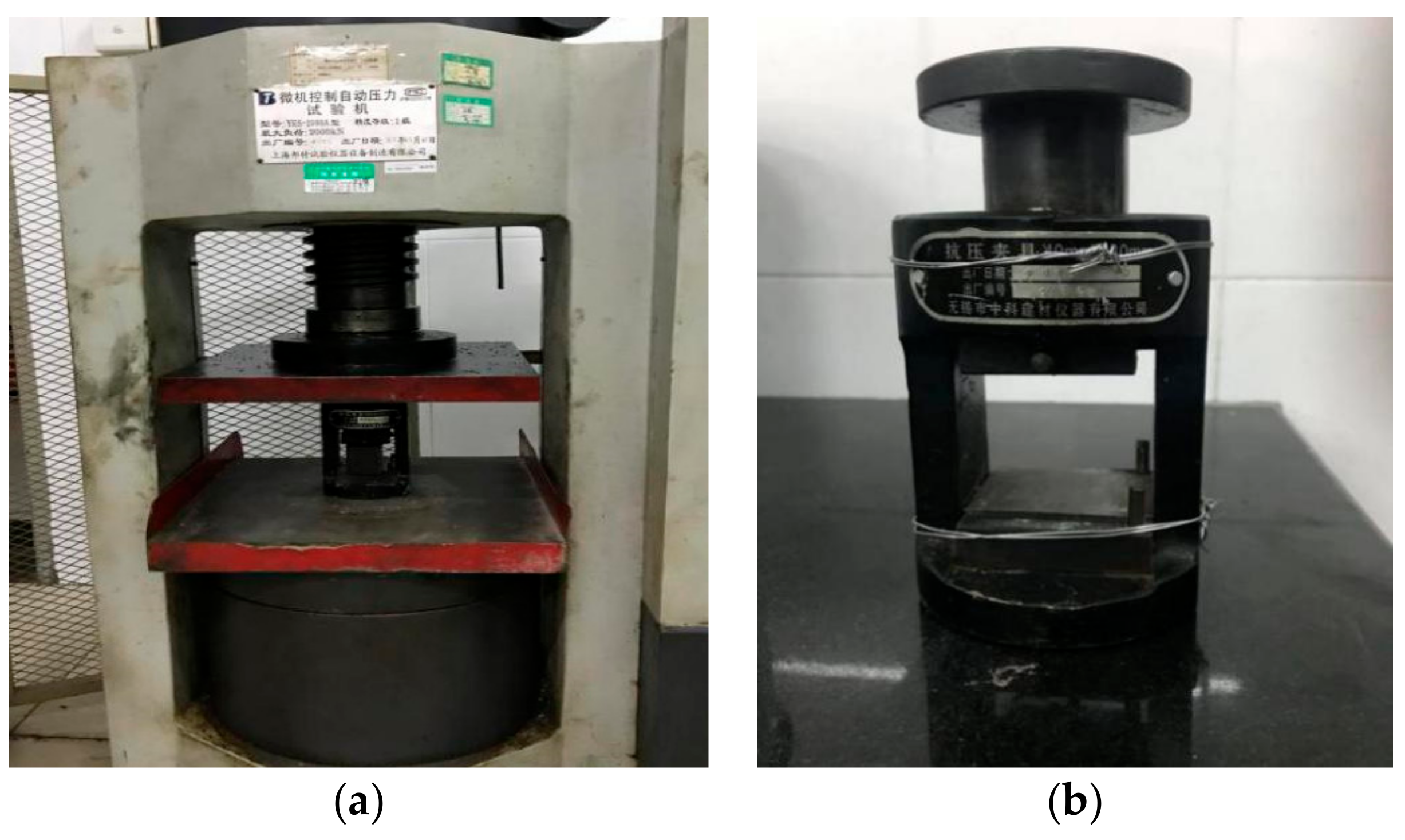
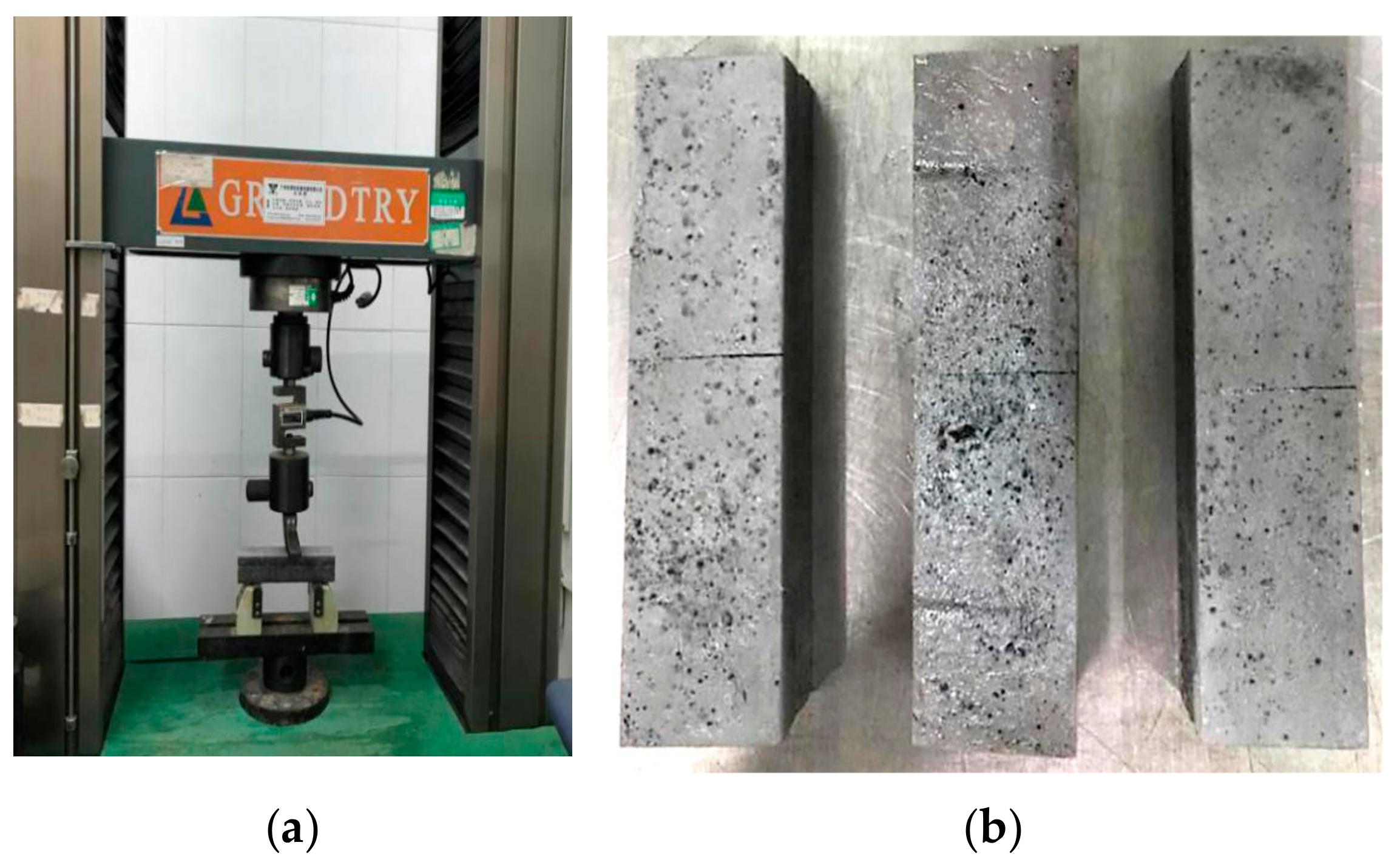
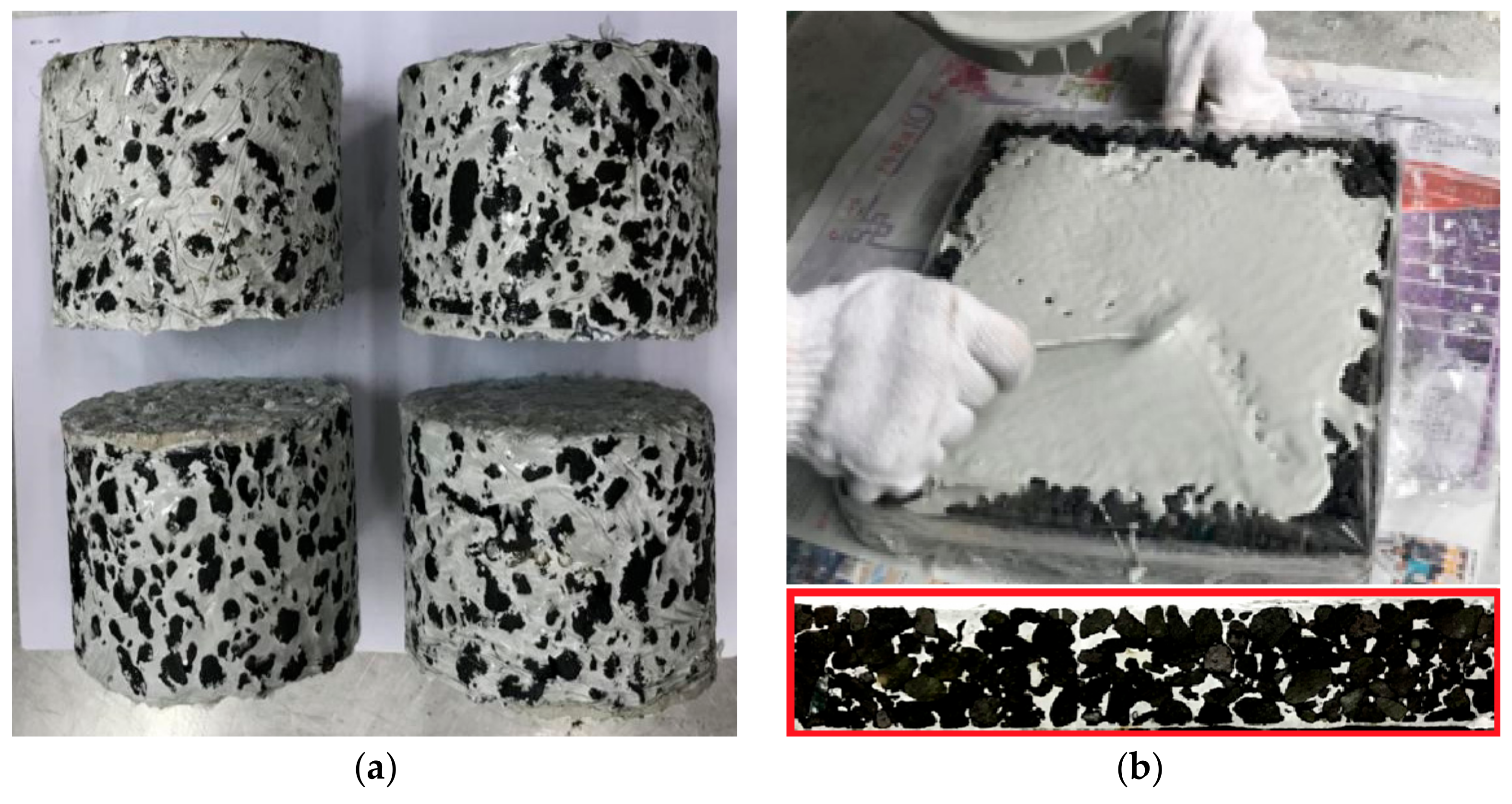
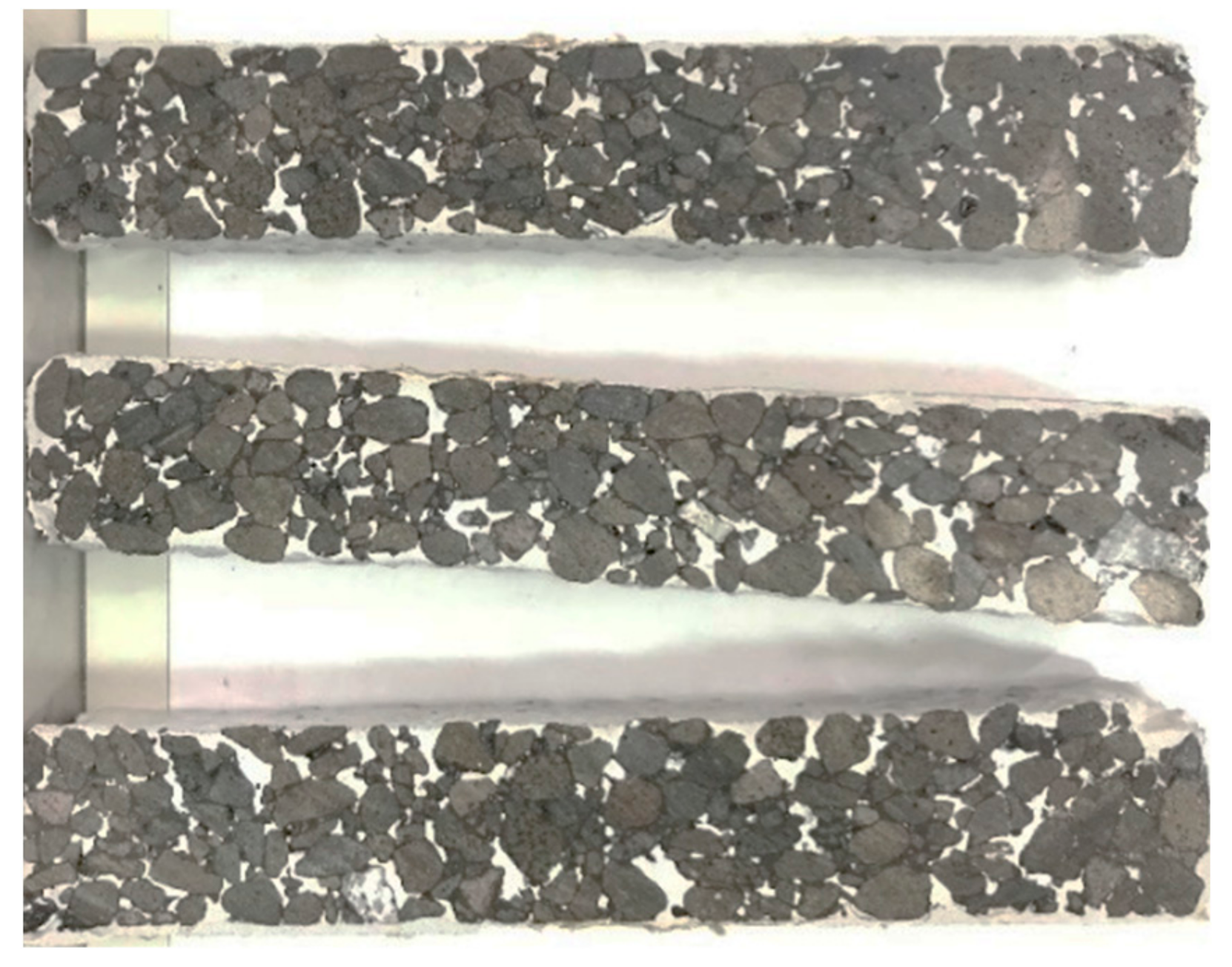
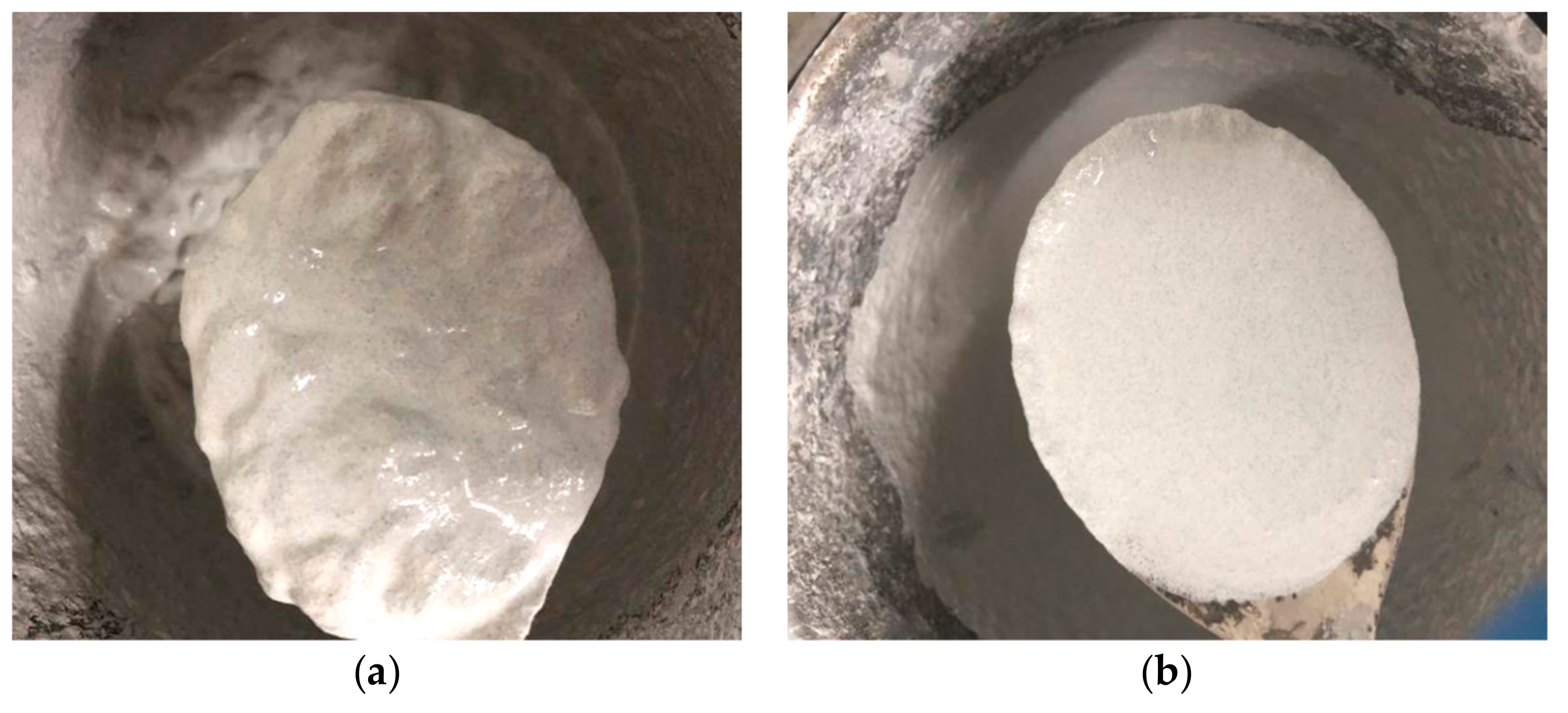
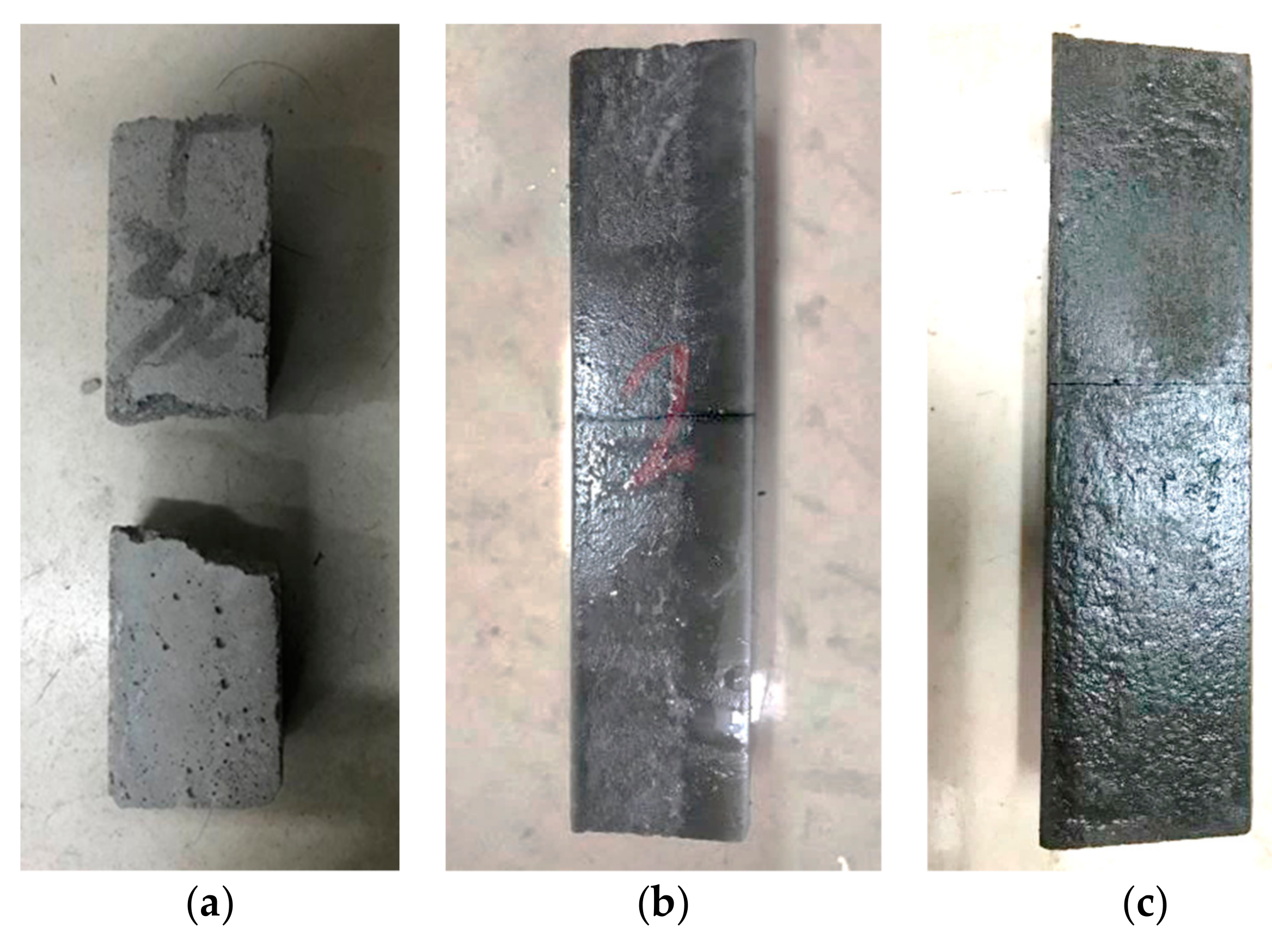
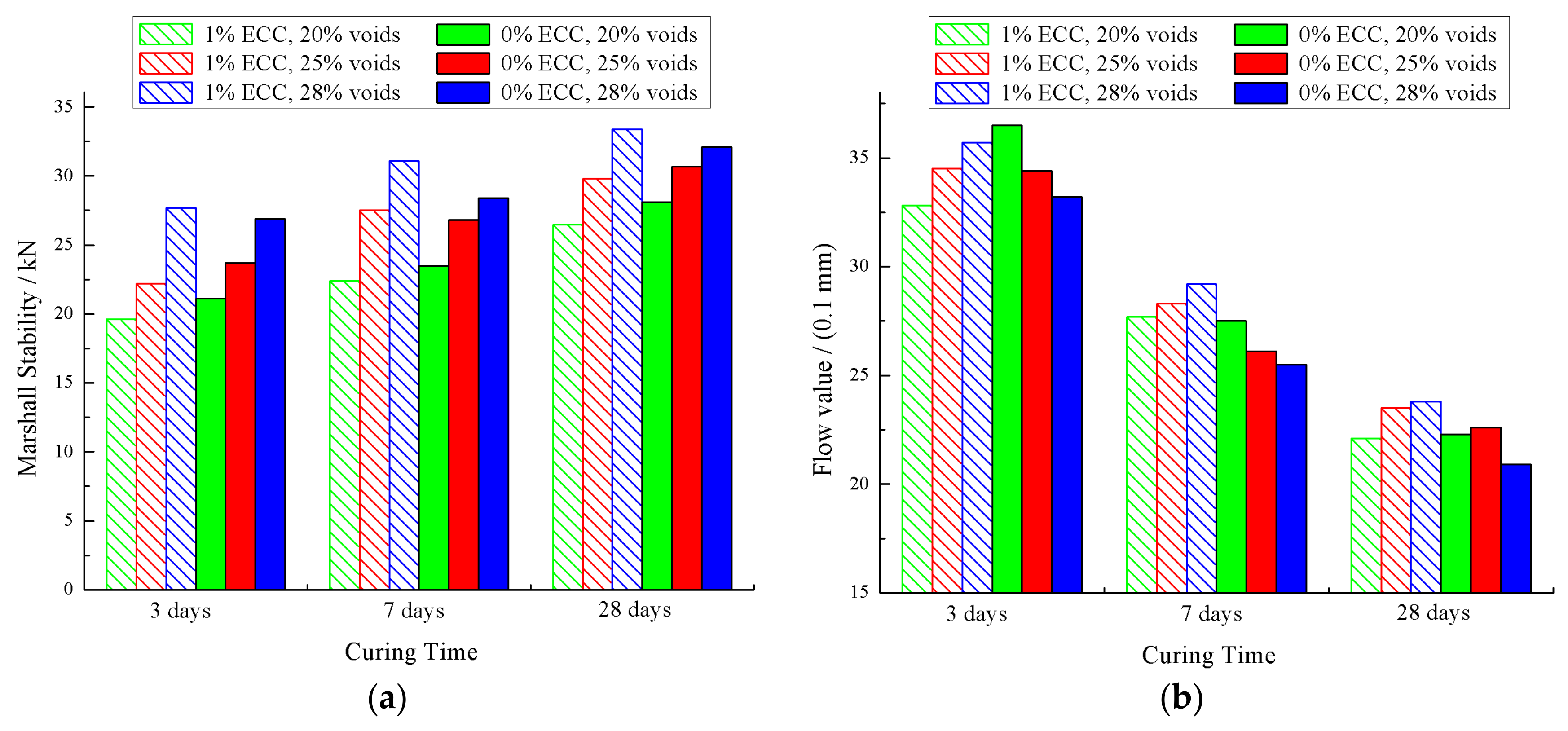
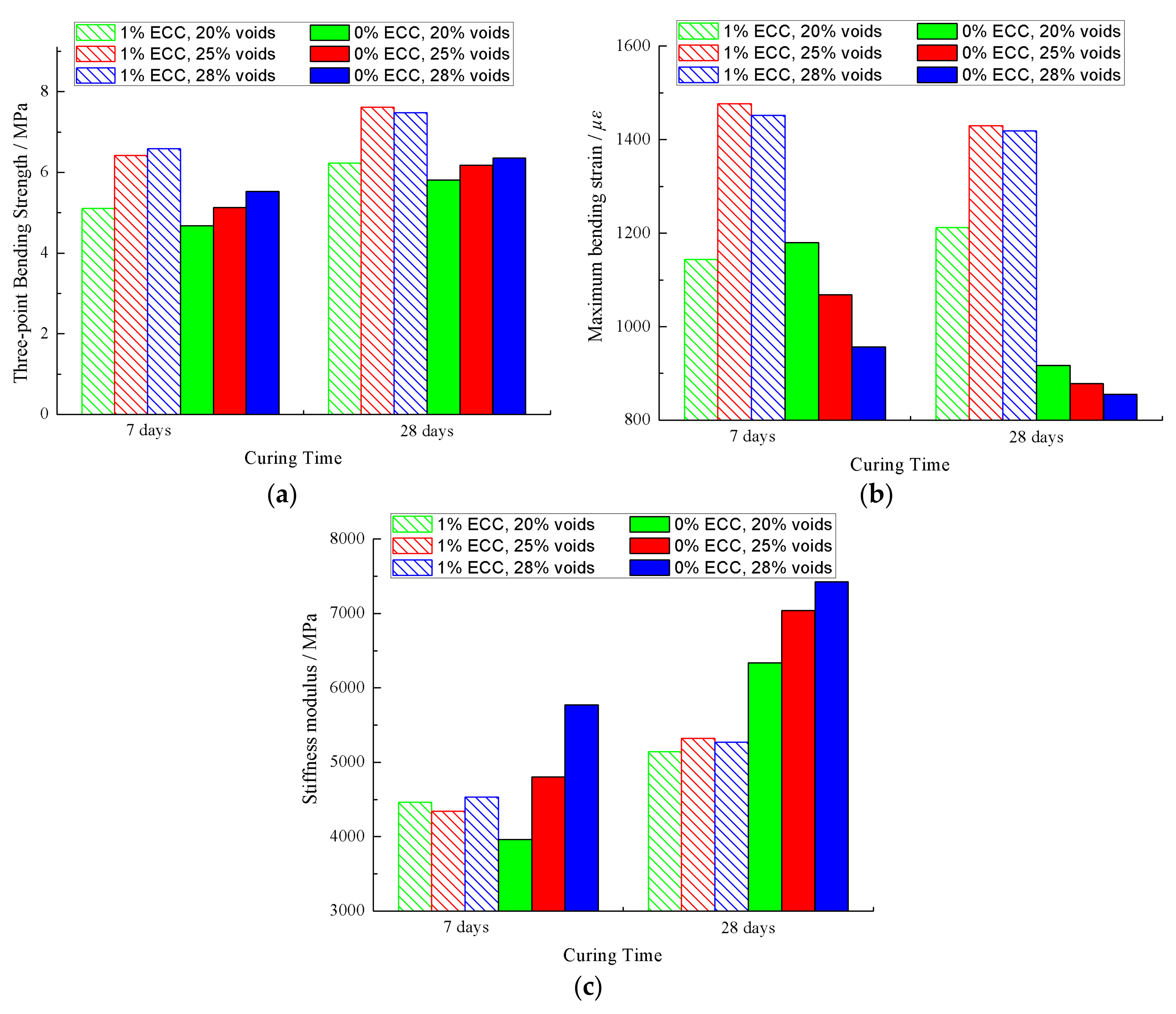
| Technical Indexes | Unit | Test Results |
|---|---|---|
| Penetration at 25 °C | 0.1 mm | 70.2 |
| Softening point | °C | 49 |
| Ductility at 10 °C | cm | 51.3 |
| Flash point | °C | 335 |
| Bitumen solubility (trichloroethylene) | % | 99.8 |
| Density at 15 °C | g/cm3 | 1.037 |
| Aggregate Types | Technical Indexes | Unit | Test Results |
|---|---|---|---|
| Coarse aggregate | Crushing value | % | 18 |
| Los Angeles abrasion | % | 25 | |
| Water absorption | % | 0.17 | |
| Apparent relative density | - | 2.679 | |
| Content of particles smaller than 0.075 mm | % | 0.55 | |
| Needle flake | % | 12 | |
| Fine aggregate | Robustness | % | 15 |
| Sand equivalent | % | 68 | |
| Apparent relative density | - | 2.568 |
| Component | Cement | Sand | Fly ash | Rubber Powder | Water Reducer | Shrinkage Reducing Agent | Other Additives |
|---|---|---|---|---|---|---|---|
| Dosage % | 38 | 25 | 25 | 3 | 0.5 | 0.7 | 7.8 |
| Density (g/cm3) | Elasticity Modulus (Gpa) | Tensile Strength (MPa) | Diameter (μm) | Elongation (%) | Length (mm) |
|---|---|---|---|---|---|
| 1.30 | 30–50 | 1600–2500 | 15 | 6 | 5–10 |
| Granular Composition | MA20 | MA25 | MA28 |
|---|---|---|---|
| Voids (%) | 20 | 25 | 28 |
| Asphalt aggregate ratio (%) | 4.0 | 3.6 | 3.3 |
| 16 mm | 100 | 100 | 100 |
| 13.2 mm | 94.6 | 94.6 | 94.6 |
| 9.5 mm | 63.5 | 64.1 | 64.4 |
| 4.75 mm | 14.7 | 12.4 | 11.9 |
| 2.36 mm | 5.9 | 4.7 | 4.3 |
| 0.075 mm | 3.5 | 3.0 | 3.0 |
| Water-Cement Ratio | Dosage (%) | Fluidity (s) | Deviation |
|---|---|---|---|
| 0.2 | 0 | 15.1 | 0.81 |
| 1 | 16.3 | 0.65 | |
| 2 | 18.5 | 1.05 | |
| 3 | 21.6 | 1.56 | |
| 0.21 | 0 | 13.6 | 0.41 |
| 1 | 15.5 | 1.01 | |
| 2 | 17.3 | 0.81 | |
| 3 | 20.5 | 1.29 | |
| 0.22 | 0 | 12.4 | 0.93 |
| 1 | 14.8 | 1.25 | |
| 2 | 16.0 | 1.14 | |
| 3 | 19.6 | 1.26 | |
| 0.23 | 0 | 10.8 | 0.53 |
| 1 | 13.2 | 0.87 | |
| 2 | 15.1 | 0.85 | |
| 3 | 18.7 | 1.53 | |
| 0.24 | 0 | 8.9 | 0.77 |
| 1 | 11.2 | 0.71 | |
| 2 | 14.5 | 1.07 | |
| 3 | 17.5 | 1.24 |
| Dosage/% | Curing Time/d | Flexural Strength (MPa) | Compressive Strength (MPa) | ||
|---|---|---|---|---|---|
| Mean | Deviation | Mean | Deviation | ||
| 0 | 3 | 8 | 0.21 | 32 | 0.57 |
| 7 | 10.6 | 0.18 | 52.3 | 0.55 | |
| 14 | 11.2 | 0.19 | 65.6 | 0.42 | |
| 28 | 13.3 | 0.14 | 75.9 | 0.68 | |
| 1 | 3 | 8.3 | 0.25 | 29.8 | 0.44 |
| 7 | 10.2 | 0.24 | 53.4 | 0.58 | |
| 14 | 12.8 | 0.64 | 65.9 | 0.75 | |
| 28 | 14.9 | 0.53 | 74.3 | 0.69 | |
| 2 | 3 | 7.9 | 0.54 | 30.3 | 0.87 |
| 7 | 10.3 | 0.49 | 51.7 | 0.74 | |
| 14 | 13.2 | 0.35 | 66.1 | 0.88 | |
| 28 | 15.5 | 0.47 | 73.6 | 0.61 | |
| Dosage (%) | Curing Condition | Specimen Code | ||||
|---|---|---|---|---|---|---|
| Single Value (%) | Mean (%) | Deviation (%) | ||||
| 1 | temp. 20 °C, humidity 10% | 1-1 | 0.5 | 3.4 | 5.4 | 8.0 |
| 1-2 | 1.1 | 7.4 | ||||
| 1-3 | 0.8 | 5.4 | ||||
| temp. 20 °C, humidity 100% | 1-4 | 2.1 | 14.1 | 13.7 | 5.5 | |
| 1-5 | 2.3 | 15.4 | ||||
| 1-6 | 1.8 | 12.1 | ||||
| temp. 60 °C, in water | 1-7 | 4.2 | 28.2 | 27.5 | 6.2 | |
| 1-8 | 4.3 | 28.8 | ||||
| 1-9 | 3.8 | 25.5 | ||||
| 2 | temp. 20 °C, humidity 10% | 2-1 | 1.1 | 7.1 | 6.7 | 3.4 |
| 2-2 | 0.8 | 5.2 | ||||
| 2-3 | 1.2 | 7.7 | ||||
| temp. 20 °C, humidity 100% | 2-4 | 2.8 | 18.1 | 16.1 | 7.6 | |
| 2-5 | 2.5 | 16.1 | ||||
| 2-6 | 2.2 | 14.2 | ||||
| temp. 60 °C, in water | 2-7 | 4.4 | 28.4 | 30.3 | 5.8 | |
| 2-8 | 4.9 | 31.6 | ||||
| 2-9 | 4.8 | 31.0 | ||||
| AC Type | Curing Condition | Specimen Code | ||||
|---|---|---|---|---|---|---|
| Single Value (%) | Mean (%) | Deviation (%) | ||||
| MA20 | temp. 20 °C, humidity 10% | 1-1 | 0.46 | 7.4 | 7.3 | 2.5 |
| 1-2 | 0.52 | 8.3 | ||||
| 1-3 | 0.38 | 6.1 | ||||
| temp. 20 °C, humidity 100% | 1-4 | 1.08 | 17.3 | 15.5 | 5.9 | |
| 1-5 | 0.87 | 14.0 | ||||
| 1-6 | 0.94 | 15.1 | ||||
| temp. 60 °C, in water | 1-7 | 1.53 | 24.6 | 24.8 | 8.8 | |
| 1-8 | 1.42 | 22.8 | ||||
| 1-9 | 1.68 | 27.0 | ||||
| MA25 | temp. 20 °C, humidity 10% | 2-1 | 0.53 | 7.0 | 5.7 | 2.6 |
| 2-2 | 0.36 | 4.7 | ||||
| 2-3 | 0.42 | 5.5 | ||||
| temp. 20 °C, humidity 100% | 2-4 | 1.25 | 16.4 | 16.1 | 2.1 | |
| 2-5 | 1.14 | 15.0 | ||||
| 2-6 | 1.29 | 17.0 | ||||
| temp. 60 °C, in water | 2-7 | 1.86 | 24.4 | 25.9 | 6.8 | |
| 2-8 | 2.13 | 28.0 | ||||
| 2-9 | 1.93 | 25.4 | ||||
| MA28 | temp. 20 °C, humidity 10% | 3-1 | 0.38 | 5.1 | 4.4 | 0.9 |
| 3-2 | 0.28 | 3.7 | ||||
| 3-3 | 0.33 | 4.4 | ||||
| temp. 20 °C, humidity 100 % | 3-4 | 1.28 | 17.1 | 16.6 | 4.3 | |
| 3-5 | 1.12 | 15.0 | ||||
| 3-6 | 1.33 | 17.8 | ||||
| temp. 60 °C, in water | 3-7 | 2.02 | 27.0 | 26.2 | 5.0 | |
| 3-8 | 1.82 | 24.3 | ||||
| 3-9 | 2.03 | 27.1 | ||||
© 2019 by the authors. Licensee MDPI, Basel, Switzerland. This article is an open access article distributed under the terms and conditions of the Creative Commons Attribution (CC BY) license (http://creativecommons.org/licenses/by/4.0/).
Share and Cite
Cai, X.; Huang, W.; Wu, K. Study of the Self-Healing Performance of Semi-Flexible Pavement Materials Grouted with Engineered Cementitious Composites Mortar based on a Non-Standard Test. Materials 2019, 12, 3488. https://doi.org/10.3390/ma12213488
Cai X, Huang W, Wu K. Study of the Self-Healing Performance of Semi-Flexible Pavement Materials Grouted with Engineered Cementitious Composites Mortar based on a Non-Standard Test. Materials. 2019; 12(21):3488. https://doi.org/10.3390/ma12213488
Chicago/Turabian StyleCai, Xu, Wenke Huang, and Kuanghuai Wu. 2019. "Study of the Self-Healing Performance of Semi-Flexible Pavement Materials Grouted with Engineered Cementitious Composites Mortar based on a Non-Standard Test" Materials 12, no. 21: 3488. https://doi.org/10.3390/ma12213488
APA StyleCai, X., Huang, W., & Wu, K. (2019). Study of the Self-Healing Performance of Semi-Flexible Pavement Materials Grouted with Engineered Cementitious Composites Mortar based on a Non-Standard Test. Materials, 12(21), 3488. https://doi.org/10.3390/ma12213488





